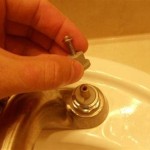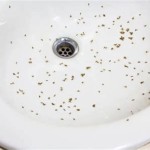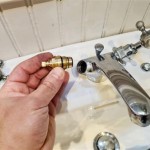What's the Best Drain Cleaner for Bathroom Sinks?
A clogged bathroom sink is a common household nuisance, often stemming from a buildup of hair, soap scum, toothpaste, and other debris. Addressing these clogs efficiently requires selecting a drain cleaner appropriate for the specific blockage and the plumbing system's material composition. A wide array of drain cleaning options exists, each with advantages and drawbacks. This article explores the various types of drain cleaners available for bathroom sinks, providing information to assist users in making informed decisions.
Understanding the nature of bathroom sink clogs is the first step in choosing the right drain cleaner. Common culprits include:
* Hair: Hair is a significant contributor to drain clogs, binding together and forming large masses that restrict water flow. * Soap Scum: The residue left behind by soaps and shampoos can accumulate over time, hardening and narrowing the drainpipe's diameter. * Toothpaste: Toothpaste, especially gel-based varieties, can solidify and contribute to clogs, particularly when combined with other debris. * Small Objects: Occasionally, small objects like cotton swabs or pieces of plastic may inadvertently enter the drain, causing obstructions.Different drain cleaners utilize different mechanisms to alleviate these blockages, and the effectiveness of each varies depending on the clog's composition and severity.
Chemical Drain Cleaners: Powerful but Potentially Damaging
Chemical drain cleaners are often the first solution many homeowners reach for due to their availability and perceived speed of action. These cleaners generally fall into two main categories: alkaline and acidic. Both types work by chemically breaking down the materials causing the clog.
Alkaline Drain Cleaners: These cleaners typically contain sodium hydroxide (lye) or potassium hydroxide as their active ingredient. They work by dissolving organic matter, such as hair and grease. Alkaline drain cleaners are often effective against common bathroom sink clogs. However, they generate heat during the chemical reaction, which can potentially damage PVC pipes if used excessively or incorrectly. It is crucial to follow the manufacturer's instructions carefully and avoid prolonged exposure to the drain.
Acidic Drain Cleaners: Acidic drain cleaners, often containing sulfuric acid, are more powerful than alkaline cleaners and are typically reserved for more severe clogs. They are particularly effective at dissolving hair, grease, and soap scum. However, acidic drain cleaners are highly corrosive and pose a significant risk to plumbing systems, especially older metal pipes. They can also cause severe burns if they come into contact with skin or eyes. Acidic drain cleaners should be used with extreme caution and are generally best left to professional plumbers.
Considerations When Using Chemical Drain Cleaners: Regardless of the type of chemical drain cleaner used, safety is paramount. Protective eyewear and gloves should always be worn to prevent skin and eye irritation. Proper ventilation is also essential, as chemical reactions can release harmful fumes. Furthermore, mixing different types of drain cleaners is strictly prohibited, as this can create dangerous chemical reactions and potentially explosive gases.
The potential for pipe damage is another critical consideration. Repeated use of chemical drain cleaners can corrode pipes, leading to leaks and costly repairs. If the plumbing system contains older metal pipes, chemical drain cleaners may accelerate the corrosion process. Alternative methods should be considered if the plumbing is old or sensitive.
Enzymatic Drain Cleaners: A Gentler Approach
Enzymatic drain cleaners offer a more environmentally friendly and less corrosive alternative to chemical drain cleaners. These cleaners utilize enzymes and bacteria to break down organic matter in the drain. The enzymes act as catalysts, accelerating the decomposition of hair, grease, soap scum, and other organic materials. The bacteria then consume the broken-down matter, effectively eliminating the clog.
Benefits of Enzymatic Drain Cleaners: Enzymatic drain cleaners are generally safe for all types of plumbing systems, including PVC, copper, and septic tanks. They do not generate heat or produce harmful fumes, making them a safer option for both users and the environment. Furthermore, regular use of enzymatic drain cleaners can help prevent future clogs by maintaining a healthy bacterial balance in the drain system and preventing the buildup of organic matter.
Limitations of Enzymatic Drain Cleaners: Enzymatic drain cleaners are typically less effective than chemical drain cleaners for clearing severe or stubborn clogs. They are best suited for preventative maintenance and for addressing minor clogs before they become major problems. The process of breaking down the clog with enzymes takes longer than with chemical cleaners, often requiring overnight soaking for optimal results. They are also less effective against inorganic materials like small objects or mineral buildup.
Proper Usage of Enzymatic Drain Cleaners: To maximize the effectiveness of enzymatic drain cleaners, follow the manufacturer's instructions carefully. Typically, this involves pouring the cleaner down the drain and allowing it to sit overnight. Avoid flushing the drain with hot water immediately after application, as hot water can kill the bacteria and reduce the cleaner's efficacy. It is best to use warm or cool water to rinse the drain after the recommended soaking period.
Mechanical Drain Cleaning Methods: Physical Removal of the Clog
Mechanical drain cleaning methods involve physically removing the clog from the drainpipe. These methods are often effective for addressing a wide range of clogs, regardless of their composition. Common mechanical drain cleaning tools include plungers, drain snakes, and wet/dry vacuums.
Plungers: A plunger is a simple yet effective tool for dislodging minor clogs. The suction created by the plunger can break up the blockage and allow water to flow freely. To use a plunger effectively, ensure there is enough water in the sink to cover the cup of the plunger. Create a tight seal around the drain opening and plunge vigorously up and down. Repeat the process several times until the clog is dislodged.
Drain Snakes (Augers): A drain snake, also known as an auger, is a flexible tool with a coiled wire that can be inserted into the drainpipe to break up or retrieve the clog. Drain snakes are available in various lengths and diameters, allowing them to reach deeper into the drain system. To use a drain snake, carefully insert the tip into the drain opening and rotate the handle to advance the snake through the pipe. When you encounter resistance, continue rotating the handle to break up the clog or hook it for removal. Slowly retract the snake, cleaning off any debris as you go.
Wet/Dry Vacuums: A wet/dry vacuum can be used to suck out clogs from the drainpipe. This method is particularly effective for removing loose debris or small objects. To use a wet/dry vacuum for drain cleaning, remove the vacuum's filter and attach a narrow hose to the end of the wand. Seal the hose around the drain opening with duct tape or a towel to create a tight suction. Turn on the vacuum and allow it to run for several minutes to suck out any debris in the drainpipe.
Advantages of Mechanical Methods: Mechanical drain cleaning methods are generally safe for all types of plumbing systems and do not involve the use of harsh chemicals. They are often effective for removing a wide range of clogs, including hair, soap scum, small objects, and mineral buildup. Furthermore, mechanical methods can be a cost-effective solution for addressing drain clogs, as the tools are relatively inexpensive and can be reused multiple times.
Disadvantages of Mechanical Methods: Mechanical drain cleaning methods can be more labor-intensive than chemical or enzymatic methods. They may also require some skill and dexterity to operate the tools effectively. In some cases, it may be necessary to disassemble parts of the drain system, such as the P-trap, to access the clog. It is crucial to avoid forcing the drain snake or other tools, as this can damage the drainpipe.
When choosing a drain cleaner for a bathroom sink, several factors must be considered. These include the type and severity of the clog, the age and material of the plumbing system, and the user's personal preferences regarding safety and environmental impact. Chemical drain cleaners offer a powerful solution for dissolving stubborn clogs but pose a risk to plumbing systems and user safety. Enzymatic drain cleaners provide a gentler, more environmentally friendly alternative but may be less effective for severe blockages. Mechanical drain cleaning methods offer a safe and effective way to physically remove clogs but may require more effort and skill. The optimal choice depends on a careful assessment of these factors.

9 Best Drain Cleaners Of 2024 For Clogged Sinks Toilets Tubs

The 10 Best Drain Cleaners In 2024

The Best Drain Cleaners Of 2024 Top Picks By Bob Vila
The Best Drain Cleaner In 2024

Green Gobbler Vs Drano Which Drain Cleaner Is Better Prudent Reviews

11 Best Drain Cleaners Of 2024 Easy Ways To Unclog Sinks And Toilets

How To Clean Drains And Unclog Shower Or Sink Today

8 Best Drain Cleaners For All Clogs In 2024 Plus Expert Tips

Power Gel Mr Muscle
What Is The Best Homemade Drain Cleaner Quora
Related Posts







